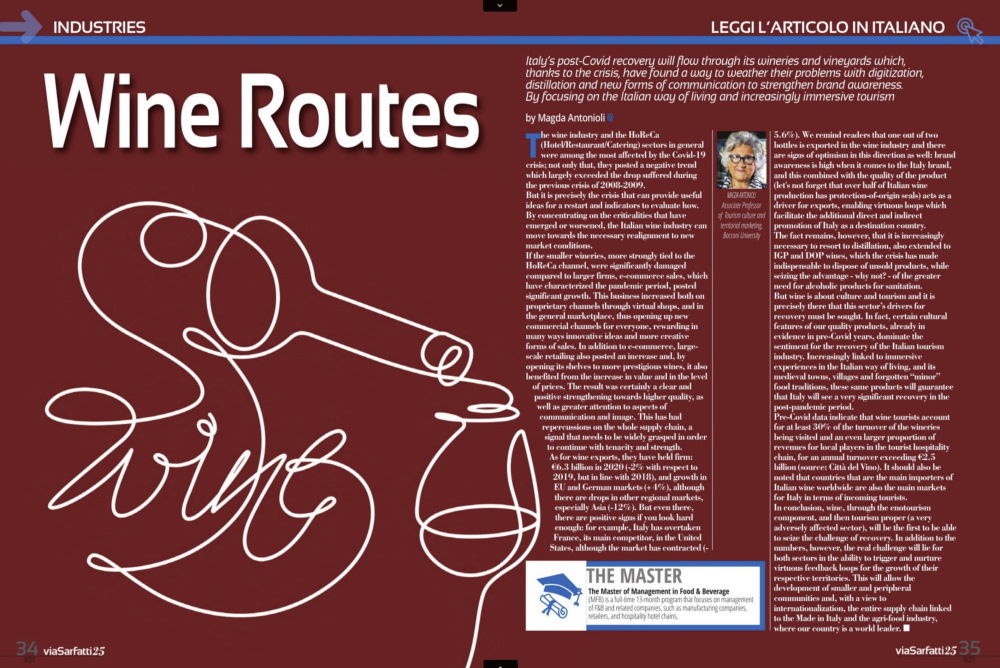
Wine Routes
ITALY'S POSTCOVID RECOVERY WILL FLOW THROUGH ITS WINERIES AND VINEYARDS WHICH, THANKS TO THE CRISIS, HAVE FOUND A WAY TO WEATHER THEIR PROBLEMS WITH DIGITIZATION, DISTILLATION AND NEW FORMS OF COMMUNICATION TO STRENGTHEN BRAND AWARENESS. BY FOCUSING ON THE ITALIAN WAY OF LIVING AND INCREASINGLY IMMERSIVE TOURISMby Magda Antonioli, Associate Professor of Tourism culture and territorial marketing, Bocconi University
The wine industry and the HoReCa (Hotel/Restaurant/Catering) sectors in general were among the most affected by the Covid-19 crisis; not only that, they posted a negative trend which largely exceeded the drop suffered during the previous crisis of 2008-2009.
But it is precisely the crisis that can provide useful ideas for a restart and indicators to evaluate how. By concentrating on the criticalities that have emerged or worsened, the Italian wine industry can move towards the necessary realignment to new market conditions.
If the smaller wineries, more strongly tied to the HoReCa channel, were significantly damaged compared to larger firms, e-commerce sales, which have characterized the pandemic period, posted significant growth. This business increased both on proprietary channels through virtual shops, and in the general marketplace, thus opening up new commercial channels for everyone, rewarding in many ways innovative ideas and more creative forms of sales.
In addition to e-commerce, large-scale retailing also posted an increase and, by opening its shelves to more prestigious wines, it also benefited from the increase in value and in the level of prices. The result was certainly a clear and positive strengthening towards higher quality, as well as greater attention to aspects of communication and image. This has had repercussions on the whole supply chain, a signal that needs to be widely grasped in order to continue with tenacity and strength.
As for wine exports, they have held firm: €6.3 billion in 2020 (-2% with respect to 2019, but in line with 2018), and growth in EU and German markets (+ 4%), although there are drops in other regional markets, especially Asia (-12%). But even there, there are positive signs if you look hard enough: for example, Italy has overtaken France, its main competitor, in the United States, although the market has contracted (-5.6%).
We remind readers that one out of two bottles is exported in the wine industry and there are signs of optimism in this direction as well: brand awareness is high when it comes to the Italy brand, and this combined with the quality of the product (let's not forget that over half of Italian wine production has protection-of-origin seals) acts as a driver for exports, enabling virtuous loops which facilitate the additional direct and indirect promotion of Italy as a destination country.
The fact remains, however, that it is increasingly necessary to resort to distillation, also extended to IGP and DOP wines, which the crisis has made indispensable to dispose of unsold products, while seizing the advantage – why not? – of the greater need for alcoholic products for sanitation.
But wine is about culture and tourism and it is precisely there that this sector’s drivers for recovery must be sought. In fact, certain cultural features of our quality products, already in evidence in pre-Covid years, dominate the sentiment for the recovery of the Italian tourism industry. Increasingly linked to immersive experiences in the Italian way of living, and its medieval towns, villages and forgotten “minor” food traditions, these same products will guarantee that Italy will see a very significant recovery in the post-pandemic period.
Pre-Covid data indicate that wine tourists account for at least 30% of the turnover of the wineries being visited and an even larger proportion of revenues for local players in the tourist hospitality chain, for an annual turnover exceeding €2.5 billion (source: Città del Vino). It should also be noted that countries that are the main importers of Italian wine worldwide are also the main markets for Italy in terms of incoming tourists.
In conclusion, wine, through the enotourism component, and then tourism proper (a very adversely affected sector), will be the first to be able to seize the challenge of recovery. In addition to the numbers, however, the real challenge will lie for both sectors in the ability to trigger and nurture virtuous feedback loops for the growth of their respective territories. This will allow the development of smaller and peripheral communities and, with a view to internationalization, the entire supply chain linked to the Made in Italy and the agri-food industry, where our country is a world leader.
Continue reading here the interviews with 8 Bocconi alumni engaged in the wine sector

